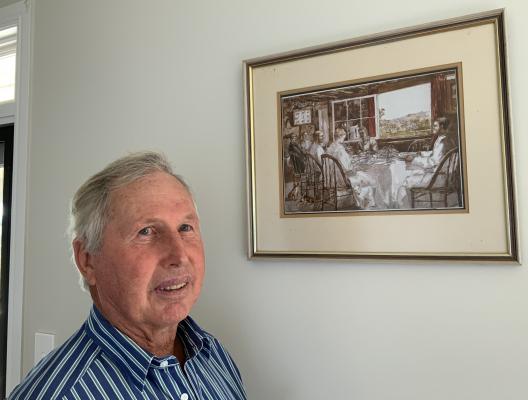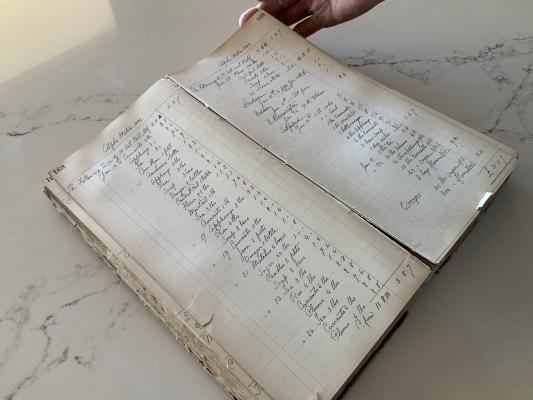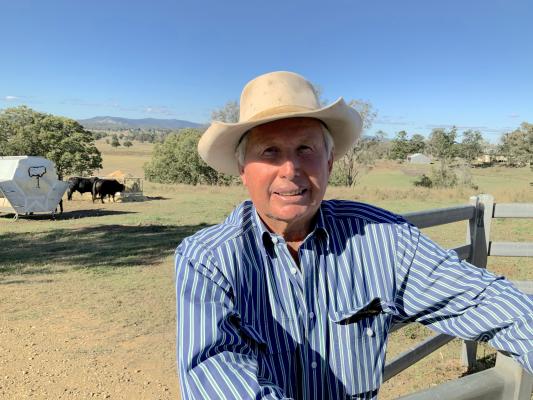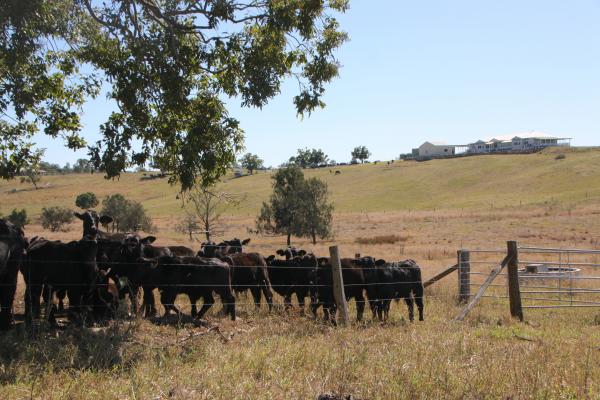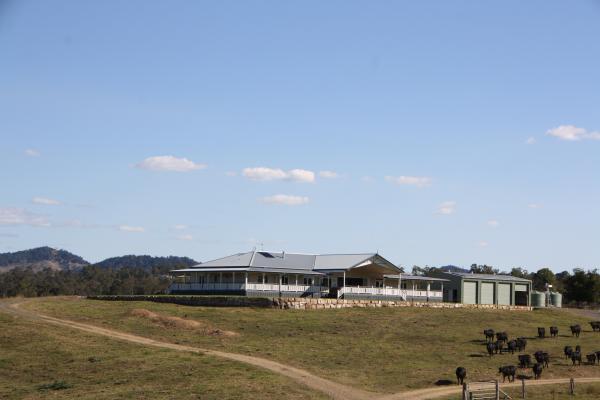A cattle station ledger and a watercolour painting, both dating back to the mid-1800s, provide links to the past yet also paths to the future. For Mary Valley cattle breeder Allen Schutt these links with history are important, as ERLE LEVEY discovers.
“The quality of the land brings out quality of produce. That’s what brought me here.“
Sitting on the veranda of Allen’s home at Lagoon Pocket, you sense the importance of history and keeping records in his breeding of Brangus cattle.
You also appreciate his devotion to the animals, his understanding of them. The curiosity they show, and their interaction with him as well as among the herd.
It’s a glorious morning and the homestead is beautifully positioned on top of a rise. Looking to the north-east over the 50-acres property that is on a bend in the Mary River, it’s an ideal place for a cuppa.
The ledger and painting are from Alpha Station in western Queensland. The entries include the price of flour, two bags for five pounds ($10), tobacco, half pound for three shillings and six pence (35cents) and a new cabbage tree hut, one pound 16 and six ($3.65).
Other handwritten entries in ink bring back the ghosts of the past – a pair of spurs, seven shillings (70cents), and the sale of horses to legendary cattle man Sidney Kidman as well as Cobb & Co for their coaches.
The watercolour painting is by Harriet Jane Neville-Rolfe who was born in England yet travelled to Alpha in 1883 to join her brother Charles.
During her two-year stay in Queensland the artist produced scores of pencil and watercolour sketches capturing day-to-day events recording station life.
Outstanding among the paintings is Breakfast at Alpha, in which the Neville-Rolfe family group is at the table.
The original is in the Queensland Art Gallery but a print hangs at Allen’s property, Kajarabie, as a reminder of the years he owned Alpha.
“The painting is of the family at the table, her brother, his wife,’’ he said. “She painted it to take home to England.
“What’s interesting is the scene outside the window, I know exactly where it is.
“In Alpha, I became aware of the history of it… that provided a link to what happened in those days.’’
To the west of the Drummond Range, Alpha was first settled by Europeans before the 1850s. Until then it was occupied by Iningai people.
Alpha Station was established in 1863.
Allen bought it around 1980 and it was about 56,000 acres at that stage.
It was a good property and he soon bought the neighbouring Star Downs. That was 84,000 acres and had been part of original Alpha Station.
He ran 3000 head of Brahman cattle at Alpha and 2000 on Star Downs, which was bigger but less developed.
“It was a wonderful lifestyle. The children all did school of the air through Longreach.
“The four of them got their education through that and the governesses until they reached the age to go off to boarding school.
“It was a good life for them … they learnt resilience, independence.’’
Eldest son Chris joined the army after pastoral college.
Karen went to University of Queensland at Gatton then went onto University of New England and got a PhD in genetics for animals. She has land at Durong and Allora, and continuing stud breeding of Brangus cattle
Andrew lives in Gympie and is a heavy machinery operator while youngest daughter Alexia lives in Toowoomba.
At Alpha, Allen found Brahman cattle to be more hardy and suited to the environment.
He moved to St George in the mid ’90s and brought Brahman cattle with him. That was Ingaby Station that comprised 25,000 acres.
Yet he found they were not as fashionable in the southern areas of Queensland as the British breeds, and not as much money in them.
He started cross-breeding the Brahmans with Simmental, Shorthorns and Angus cattle.
“I found Brahman Angus cross the most suitable for me and more acceptable to the southern beef market at that stage.
“I found the fertility of the Angus and the hardiness of the Brahman was a cross that suited and was readily marketable.’’
It was a good block of country on the Ballone River. There was irrigation so it enabled fodder cropping as well as grazing.
Before then he had spent a number of years at Warana Downs, 6000 acres of softwood scrub country at Wandaon.
“We had wanted to get closer to schools and facilities but the whole seven years we were in drought, so cattle were on agistment. We were at St George for 20 years.’’
The move to the Mary Valley was very considered. He looked right through the area – Mt Mee, Maleny, Cooroy – but felt they were already developed.
The regular rainfall, quality of the soil and the sense of community as well as facilities the Mary Valley offered also appealed.
“I just think this area has terrific potential,’’ he said. “It’s so close to Gympie and the Sunshine Coast
“When I had St George it built up to 700 registered cows. Now I’ve got 50.
“I sold a lot to other cattle studs at St George and the kids have got some as well to develop their own studs.
“The quality of the land brings out quality of produce. That’s what brought me here.
“I decided to retire and was getting tired of the dry years. Semi-retire really. I wanted to run cattle but not move to the coast, help the kids get established and have an easier lifestyle.
“It’s good to sit back and see they are all set up.’’
Lagoon Pocket offered a good climate. At St George the temperature would range from minus four and five degrees in winter to 41 degrees in summer.
Kajarabie comprises some river flats while the rest is undulating grazing country.
The property had been a dairy farm and the soil is generally loamy.
“I can irrigate from the river, and have set the whole place up with solar pump, water troughs to every paddock. It’s all underground water to the troughs.
“The property offers shade for the cattle without being heavily timbered. There are established pastures that I have fertilised. I did not want to plough any of it.
“Kajarabie is a registered stud, named after where I was at St George, right at junction of Ballone and Maranoa Rivers. The Beardmore Dam was just below the junction and the water that backed up was called Lake Kajarabie.
“Supplement feed stations are throughout the property as the coast country needs calcium and phosphorous … the rainfall tends to leach it out.
“Further west you don’t have that. So, I’m trading rainfall for dry areas.’’
The Lagoon Pocket property was a blank canvas for Allen. No house, no yards.
“I thought I could make something of it. A great investment.
“I could have bought on the beach but would have been bored. This was the best option.’’
Allen built the house, the sheds and steel cattle yards when he arrived.
The homestead, designed by Col Gluch and built by KJ Homes, was a section winner in the Master Builders Sunshine Coast Housing Awards.
He has the property set up into 10 paddocks and rotates the cattle through them to allow the pasture to regenerate quicker.
The move to a higher rainfall area has meant getting used to cattle ticks … there were none in western Queensland.
Alpha was basically the tick line, also the line between farming and grazing.
Allen does his own artificial insemination of his cattle, having been an AI technician in the past.
He gets satisfaction out of improving the line of the cattle through breeding.
“I look at the bull and the breed figures, put him over a cow and see the progeny.
“I don’t buy a bull without checking the EBV (estimated breeding value), then purchase the semen.
“I’m looking for the best time between gestation. It takes nine months to produce a calf and I want one every 12 months.
“All traits are heritable.’’
He mainly sells to repeat buyers because you know you are doing the right thing if they keep coming back.
Buyers are throughout Australia – to Northern Territory, also Queensland and New South Wales not so much Victoria due to the tropical element of the breed.
Allen has been at Lagoon Pocket for three and a bit years and looks back at being able to establish Kajarabie pretty much as he wanted.
He has had a stint as president Australian Brangus Cattle Association and been on the board for a few years.
“I love the outback but always wanted a place on the river. Permanent water is a big thing really.’’
Allen turns again to the ledgers from Alpha Station.
“All handwritten. One of the fellows in the painting was the bookkeeper and he did all this.
“That sort of history, just priceless.’’


